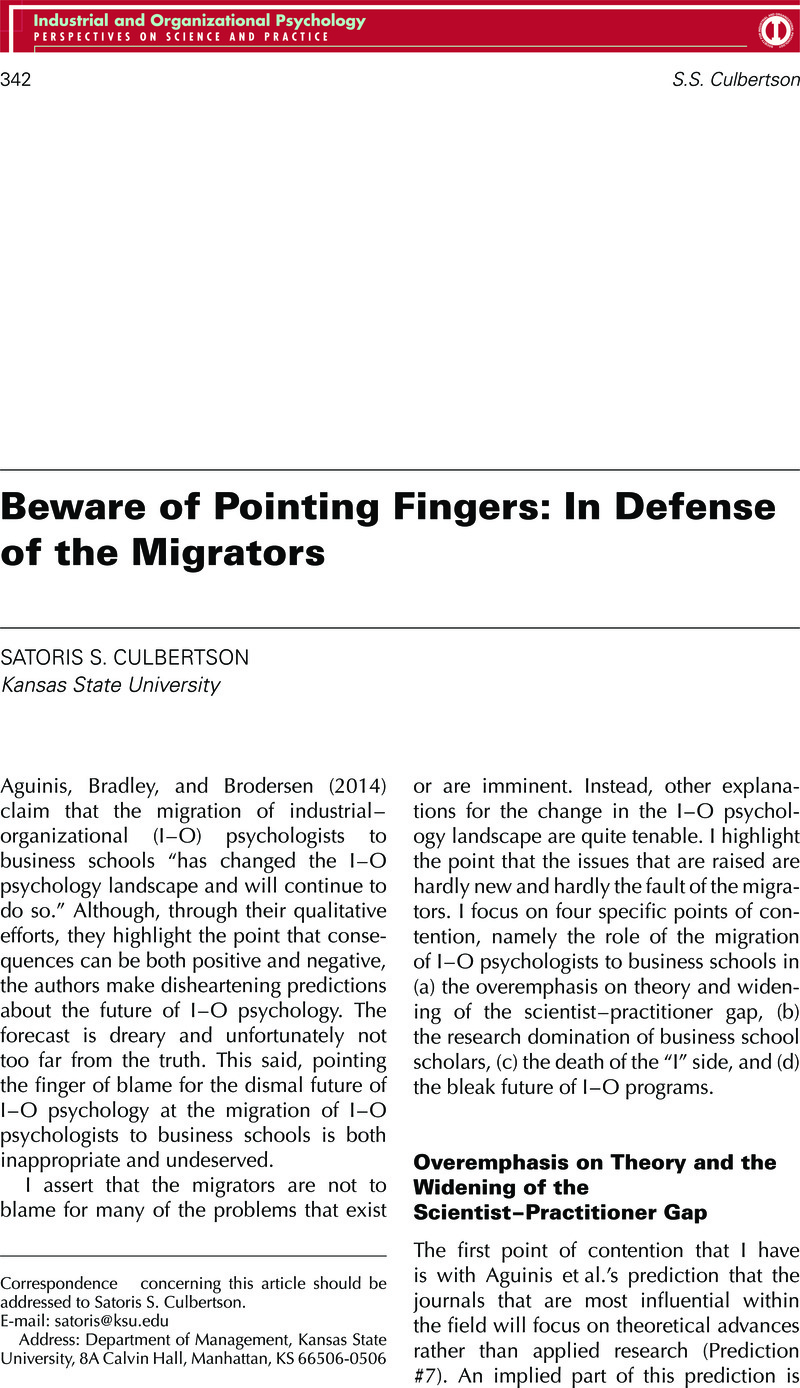No CrossRef data available.
Article contents
Beware of Pointing Fingers: In Defense of the Migrators
Published online by Cambridge University Press: 07 January 2015
Abstract
An abstract is not available for this content so a preview has been provided. Please use the Get access link above for information on how to access this content.

- Type
- Commentaries
- Information
- Copyright
- Copyright © Society for Industrial and Organizational Psychology 2014
References
Aguinis, H., Bradley, K. J., & Brodersen, A. (2014). Industrial–organizational psychologists in business schools: Brain drain or eye opener? Industrial and Organizational Psychology: Perspectives on Science and Practice, 7(3), 284–303.Google Scholar
Bulger, C. A., Horvath, M., & Zickar, M. (2006). Industrial-organizational (I-O) psychology graduate school rankings: A guide for I-O graduate school applicants. The Industrial-Organizational Psychologist, 43(3), 121–131.Google Scholar
Colquitt, J. A., & Zapata-Phelan, C. P. (2007). Trends in theory building and theory testing: A five-decade study of the Academy of Management Journal. Academy of Management Journal, 50, 1281–1303. doi: 10.5465/AMJ.2007.28165855CrossRefGoogle Scholar
Dunnette, M. D. (1976). Toward fusion. In Dunnette, M. D. (Ed.), Handbook of industrial and organizational psychology (pp. 1–12). Chicago, IL: Rand McNally.Google Scholar
Godard, J. (2014). The psychologisation of employment relations? Human Resource Management Journal, 24, 1–18. doi: 10.1111/1748-8583.12030Google Scholar
Highhouse, S. (2007). Where did this name come from anyway? A brief history of the I-O label. The Industrial-Organizational Psychologist, 45(1), 53–56.Google Scholar
Kerr, S. (1975). On the folly of rewarding A, while hoping for B. Academy of Management Journal, 18, 769–783. doi: 10.2307/255378CrossRefGoogle ScholarPubMed
Ones, D. S., & Viswesvaran, C. (2000). Most published authors in Journal of Applied Psychology and Personnel Psychology during the 1990s. The Industrial-Organizational Psychologist, 37(4), 26–35.Google Scholar
Ployhart, R. E. (2014). The study of phenomena that matter. In Ford, J. K., Hollenbeck, J. R., & Ryan, A. M. (Eds.), The nature of work: Advances in psychological theory, methods, and practice (pp. 259–275). Washington, DC: American Psychological Association. doi: 10.1037/14259-013Google Scholar
Podsakoff, P. M., MacKenzie, S. B., Podsakoff, N. P., & Bachrach, D. G. (2008). Scholarly influence in the field of management: A bibliographic analysis of the determinants of university and author impact in the management literature in the past quarter century. Journal of Management, 34, 641–720. doi: 10.1177/0149206308319533Google Scholar
Rynes, S. L. (2012). The research-practice gap in I/O psychology and related fields: Challenges and potential solutions. In Kozlowski, S. (Ed.), Oxford handbook of organizational psychology (Vol. 1, pp. 409–452). New York, NY: Oxford University Press. doi: 10.1093/oxfordhb/9780199928309.013.0013Google Scholar


